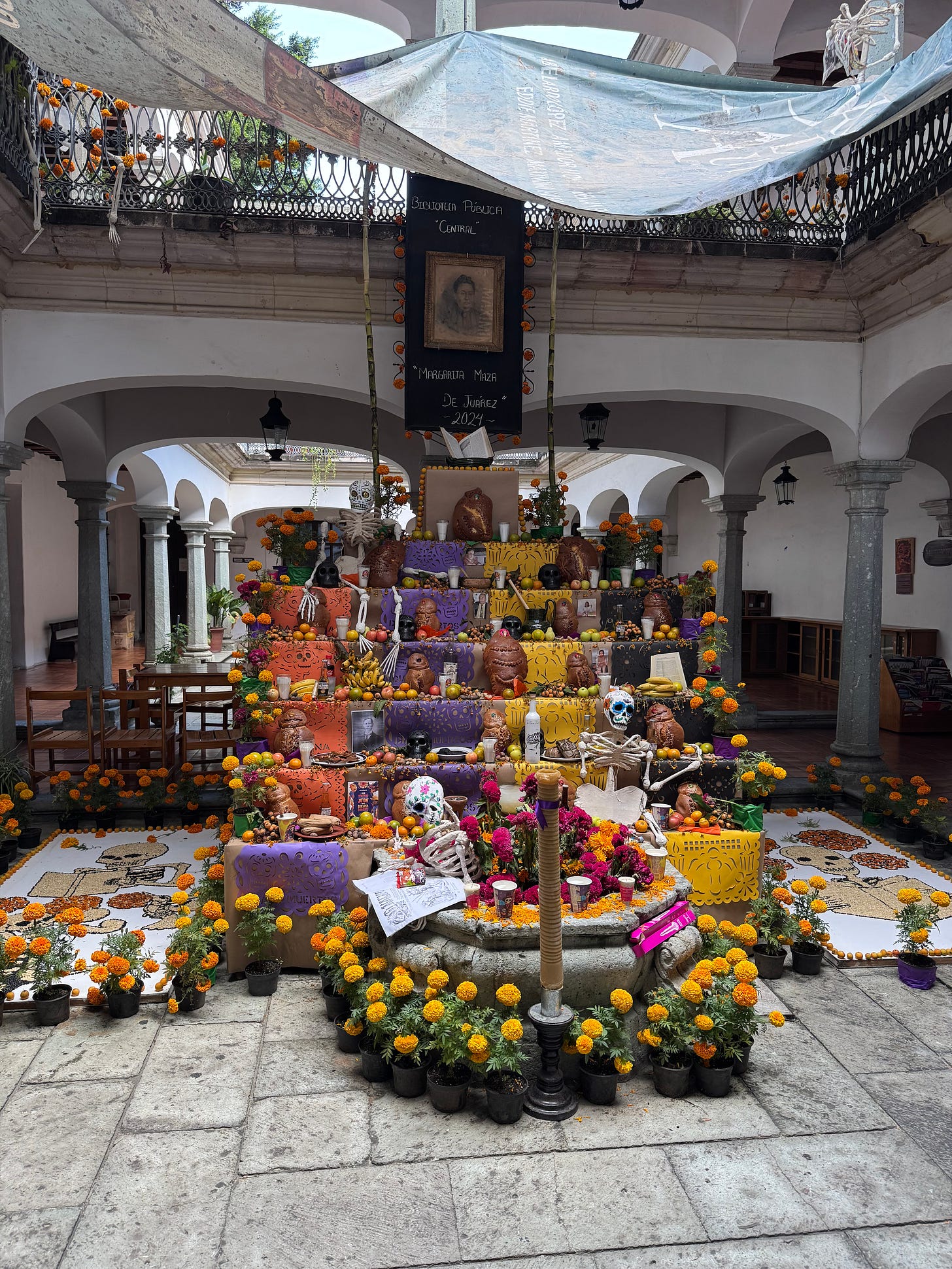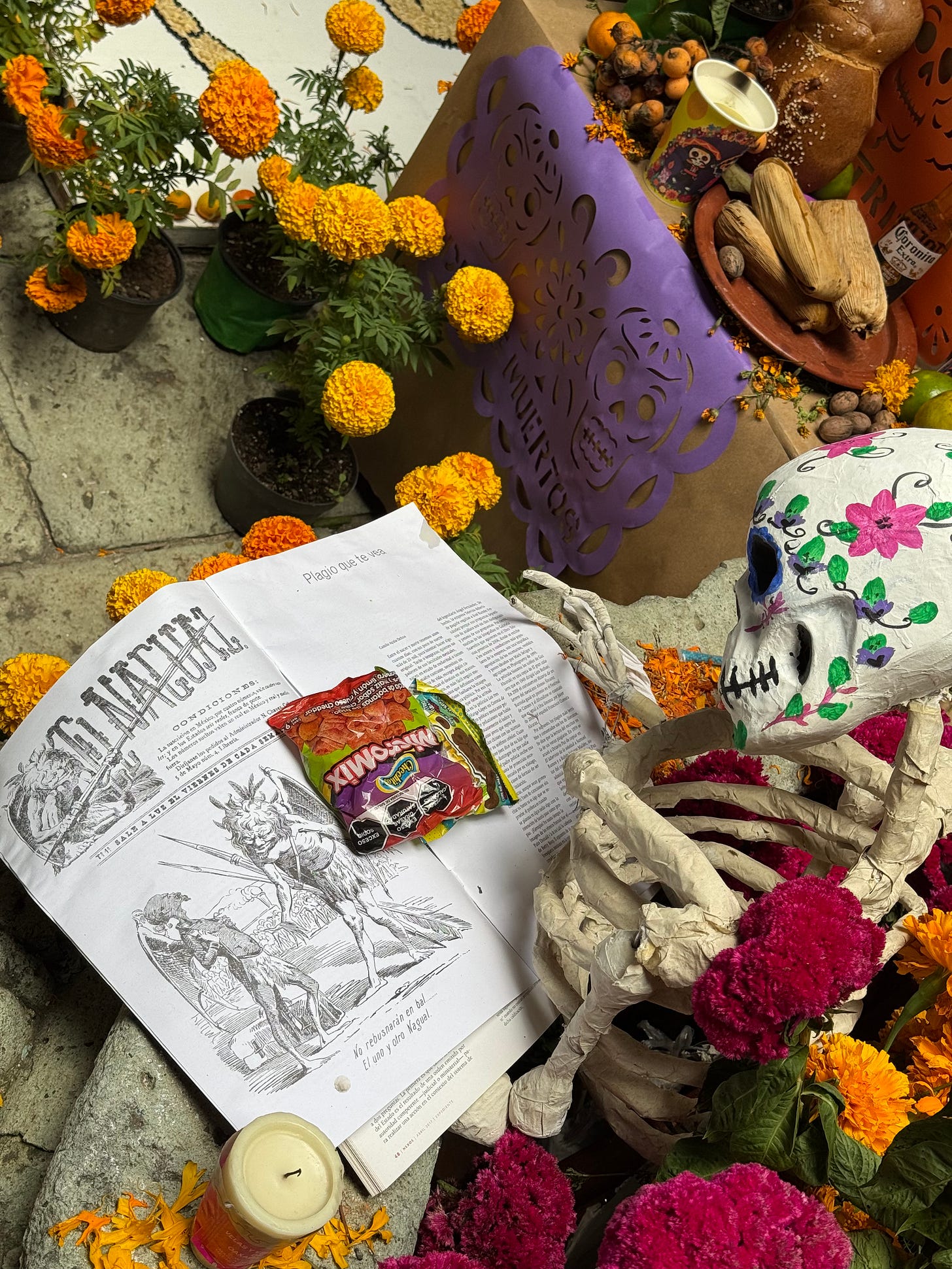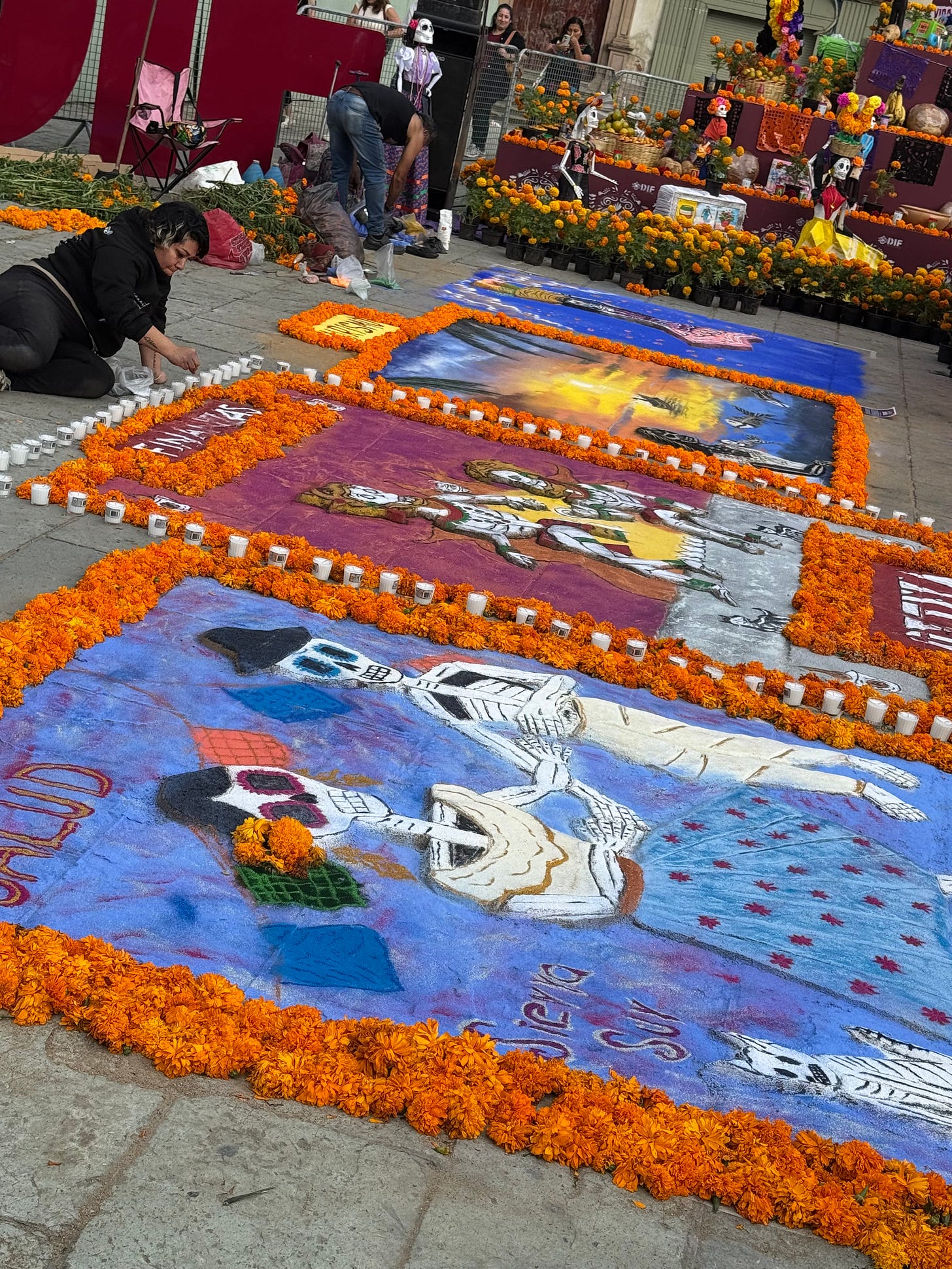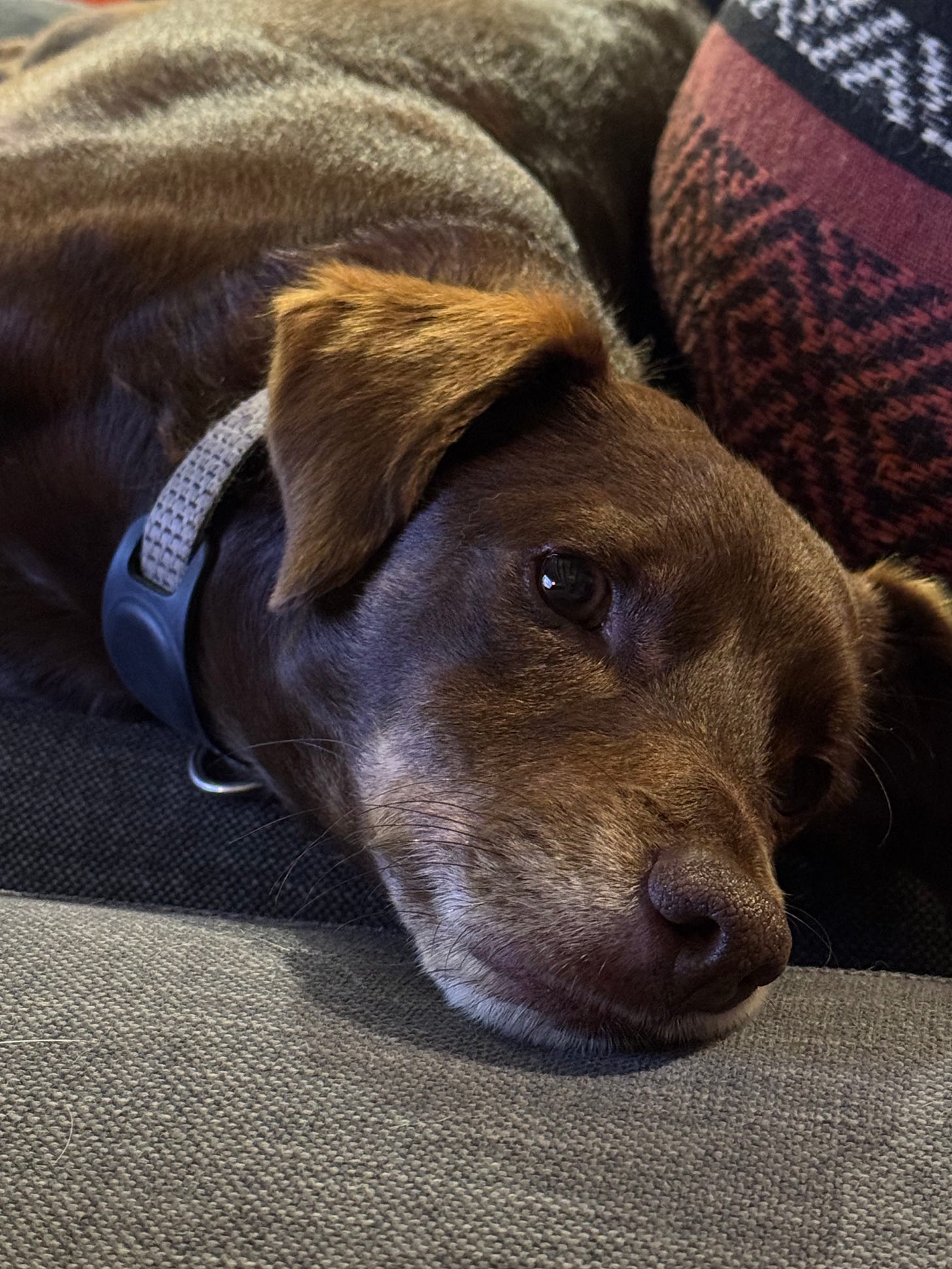How to Build an Ofrenda for Día de Muertos
Mexico's Día de Muertos—the Day of the Dead—revolves around an altar built for loved ones lost.
In Mexico, death is an old friend who every year is welcomed into the home.
Mexico's reputation for dangerousness is a topic I’ve written about quite a few times before and that reputation, while grounded in some degree of truth, is also greatly exaggerated. The Mexican acceptance of death and its prominence in Mexican art and cultural expression is not connected to the damage done by the country’s cartels, nor is Día de Muertos, the Day of the Dead, a form of gallows humor that serves to make a heartrending topic more palatable.
Día de Muertos is, instead, a celebration of the life of people who are now gone, and it is both a figurative and literal way of recalling them to the world in which we live. Not only does Día de Muertos give people a chance to remember and celebrate those who have died, it is also a celebration intended to summon their spirits back to the land of the living.
Día de Muertos has effectively three components; the celebration in the community, which has a Carnivale-like atmosphere; the graveside celebration in a panteón (a cemetery) that generally is not open to the public; and the celebration in the home, which is centered around the ofrenda.
What Is an Ofrenda?
An ofrenda is a type of spiritual altar people construct in homes, businesses, and even sometimes in public places.
An ofrenda is supposed to do two particular things. One is that it serves as a gathering place where people can remember and celebrate the deceased. People will look at the ofrenda, which is lit by candles and set with a variety of ceremonial items, and, hopefully, they’ll think of the cherished moments they shared. It’s supposed to be a place not of sorrow but of joyous recollection.
The other function of an ofrenda is that it is a spiritual focal point. The ofrenda is decorated with an assortment of common items important to the ceremony as well as food and drinks specifically beloved by the deceased. The combination of those things is supposed to make it easier for the spirits of the dead to find their way back to the realm of the living. The ofrenda is the central pillar of a Día de Muertos celebration. It doesn’t just help people remember those who are gone, it is supposed to literally draw the dead back to their living relatives for one night out of the year.
What Goes on an Ofrenda?
An ofrenda carries items particular to the people you wish to honor and entice back to the land of the living, and a set of common items, widely sold around the holiday, that are found on every ofrenda.
Common Items for an Ofrenda
Common items include:
Candles and candlesticks (respectively called velas and veladoras). Candles can be either plain, church-style votives or can be elaborate and handmade, often resembling skulls lined with flowers.
Incense made from copal resin (copal is a type of tree common in Oaxaca).
Flowers such as cempesúchil (marigolds), cresta de gallo (cockscomb), and types of wildflowers broadly called flor de muerto. Cempasúchil colors include yellow and various shades of orange. Cresta de gallo should be pink or crimson red. Flor de muerto isn’t a specific type of flower and that name instead describes a range of wild-growing flowers that resemble cempesúchil. Wild flor de muerto flowers are often used by people with less money, as they’re easy to forage and are less expensive to purchase. The color and aroma of the flowers is said to make it easier for the dead to find their way home.
Pan de muerto, a category of bread made during the time of Día de Muertos. Pan de muerto takes several forms, ranging from small buns with a cross-like design on them to larger sesame seed studded loaves that have a small face embedded in them made from hardened, painted flour.
Mole (pronounced mo-lay), a category of Oaxacan salsa (sauce). Mole is typically made from many ingredients that are ground together into a smooth paste which is then thinned into a silky smooth sauce.
Water, to quench the thirst of the dead.
Salt, which symbolizes purification.
Sugar skulls, a type of dulce (candy).
Mezcal, Oaxaca’s most famed distilled spirit.
A tablecloth and festive paper decorations.
Personal Items for an Ofrenda
Photographs of the deceased.
Favorite foods or drinks of the deceased.
Constructing the Ofrenda
In general, ofrendas have multiple tiers. The base level is said to represent the earth and is placed with items such as food and drink, while the upper level(s), representing heaven or the afterlife, carry the images of the deceased.
Ofrends are draped with tablecloths, on top of which are placed all of the items and decorations you’ve assembled.
While there are many rules about what should go on an ofrenda and how it should be constructed you have a great amount of artistic license with how it’s set up. While it’s important to use the vital elements described above, you’re effectively free to decorate your ofrenda as you wish! We’ve even seen ofrendas set up for both people and pets, and they can range from being quite simple to being extremely expensive and elaborate.
Cultural Appropriation
The construction of the ofrenda does have rules and guidelines, especially for those who are genuinely trying to engage in the spiritual practices that involve it. If you deviate too much you can stray into the territory of cultural appropriation—stealing the trappings of something without appropriately honoring the culture from which it arises. For that reason, it’s important to understand Mexican culture and the specific culture surrounding Día de Muertos and ofrendas.
That being said, the shape, size, arrangement, and construction of ofrendas differ from person to person, so there’s no “right” way to build one. For many people, the ofrenda is purely symbolic, tied to culture and not religion.
If you want to build an ofrenda and don’t live in Mexico or aren’t of Mexican heritage, it’s a great idea to read more about Día de Muertos so that you have a deeper understanding of the tradition. This holiday isn’t simply a Mexican version of Halloween, and while it is a huge celebration with a joyous (and often very intoxicated) party that accompanies it, it’s also very culturally significant. It’s important that your ofrenda helps you remember your loved ones and that you’ve set it up in a way that satisfies you, while also not hugely deviating from what makes this a very specific, very intentional holiday that has ties to Mexico’s indigenous peoples.
If you want to dip your toes into the water, understand the nature of the ocean you’re about to wade into!
Additional Resources
Gobierno de Mexico (GOB): Conoces el significado de los elementos de una ofrenda de Día de Muertos? (Do you know the meaning of the elements of a Day of the Dead offering?)
Smithsonian National Museum of the American Latino: Day of the Dead Resources (Recursos de Día de Muertos)
Mexico in my Kitchen: Day of the Dead Bread | Pan de Muerto






¡Gracias! Very informative!